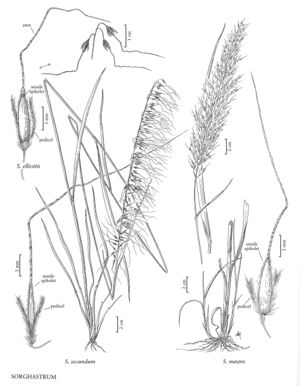Difference between revisions of "Sorghastrum elliottii"
FNA>Volume Importer |
imported>Volume Importer |
||
| (6 intermediate revisions by 2 users not shown) | |||
| Line 4: | Line 4: | ||
|publications= | |publications= | ||
|common_names=Slender indiangrass | |common_names=Slender indiangrass | ||
| + | |special_status={{Treatment/ID/Special_status | ||
| + | |code=E | ||
| + | |label=Endemic | ||
| + | }} | ||
|basionyms= | |basionyms= | ||
|synonyms={{Treatment/ID/Synonym | |synonyms={{Treatment/ID/Synonym | ||
|name=Sorghastrum apalachicolense | |name=Sorghastrum apalachicolense | ||
| − | |authority= | + | |authority= |
| + | |rank=species | ||
}} | }} | ||
|hierarchy=Poaceae;Poaceae subfam. Panicoideae;Poaceae tribe Andropogoneae;Sorghastrum;Sorghastrum elliottii | |hierarchy=Poaceae;Poaceae subfam. Panicoideae;Poaceae tribe Andropogoneae;Sorghastrum;Sorghastrum elliottii | ||
| Line 29: | Line 34: | ||
-->{{#Taxon: | -->{{#Taxon: | ||
name=Sorghastrum elliottii | name=Sorghastrum elliottii | ||
| − | |||
|authority=(C. Mohr) Nash | |authority=(C. Mohr) Nash | ||
|rank=species | |rank=species | ||
| Line 36: | Line 40: | ||
|basionyms= | |basionyms= | ||
|family=Poaceae | |family=Poaceae | ||
| + | |illustrator=Linda A. Vorobik;Annaliese Miller | ||
| + | |illustration copyright=Utah State University | ||
|distribution=Md.;Okla.;Miss.;Tex.;La.;Ala.;Tenn.;N.C.;S.C.;Va.;Ark.;Ga.;Ind.;Fla. | |distribution=Md.;Okla.;Miss.;Tex.;La.;Ala.;Tenn.;N.C.;S.C.;Va.;Ark.;Ga.;Ind.;Fla. | ||
|reference=None | |reference=None | ||
|publication title= | |publication title= | ||
|publication year= | |publication year= | ||
| − | |special status= | + | |special status=Endemic |
| − | |source xml=https:// | + | |source xml=https://bitbucket.org/aafc-mbb/fna-data-curation/src/200273ad09963decb8fc72550212de541d86569d/coarse_grained_fna_xml/V25/V25_1536.xml |
|subfamily=Poaceae subfam. Panicoideae | |subfamily=Poaceae subfam. Panicoideae | ||
|tribe=Poaceae tribe Andropogoneae | |tribe=Poaceae tribe Andropogoneae | ||
Latest revision as of 17:57, 11 May 2021
Plants not rhizomatous. Culms 70-190 cm tall, 1.2-2.4 mm thick; internodes glabrous. Sheaths mostly glabrous, throats pubescent; ligules 2-5 mm, decurrent, ciliate; blades 20-55 cm long, 2.5-5.5(8) mm wide, mostly glabrous. Panicles 10-35 cm, open, arching, dark purple; rachises 0.3-0.8 mm thick 1-2 mm above the lowest node; branches capillary, flexible, longest branches 19.5-34.5 cm. Spikelets 6-7.5 mm long, 1.1-1.4 mm wide, dark chestnut brown at maturity. Calluses 1-1.3 mm, blunt; lower glumes 5.5-7.3 mm, glabrous, 5-veined; upper glumes 6.2-7.5 mm; awns 25-40 mm, 5 times longer than the spikelets, twice-geniculate; anthers 2-3 mm. Caryopses 2-2.5 mm. Pedicels 3-6.5 mm, flexuous. 2n = 20.
Distribution
Md., Okla., Miss., Tex., La., Ala., Tenn., N.C., S.C., Va., Ark., Ga., Ind., Fla.
Discussion
Sorghastrum elliottii usually grows in dry, open woods on sandy terraces of the lowlands in the southeastern United States, often over a clay subsoil. Plants with straight panicles and sessile spikelets that are 1.3-1.8 mm wide are sometimes called S. apalachicolense D.W. Hall, but the variation appears to be continuous and such plants are included here as S. elliottii.
Selected References
None.
